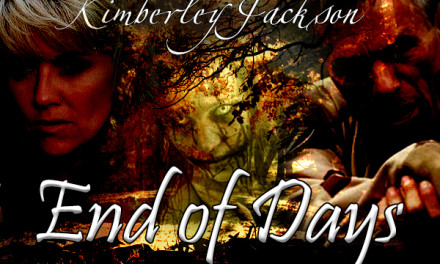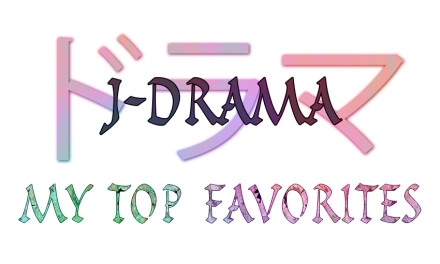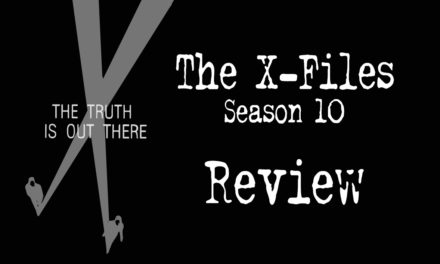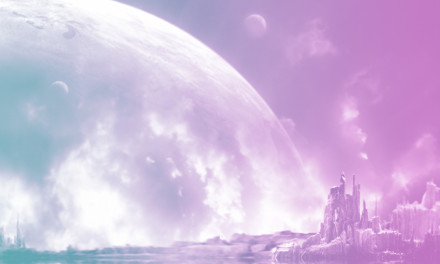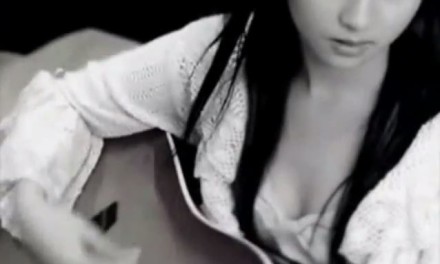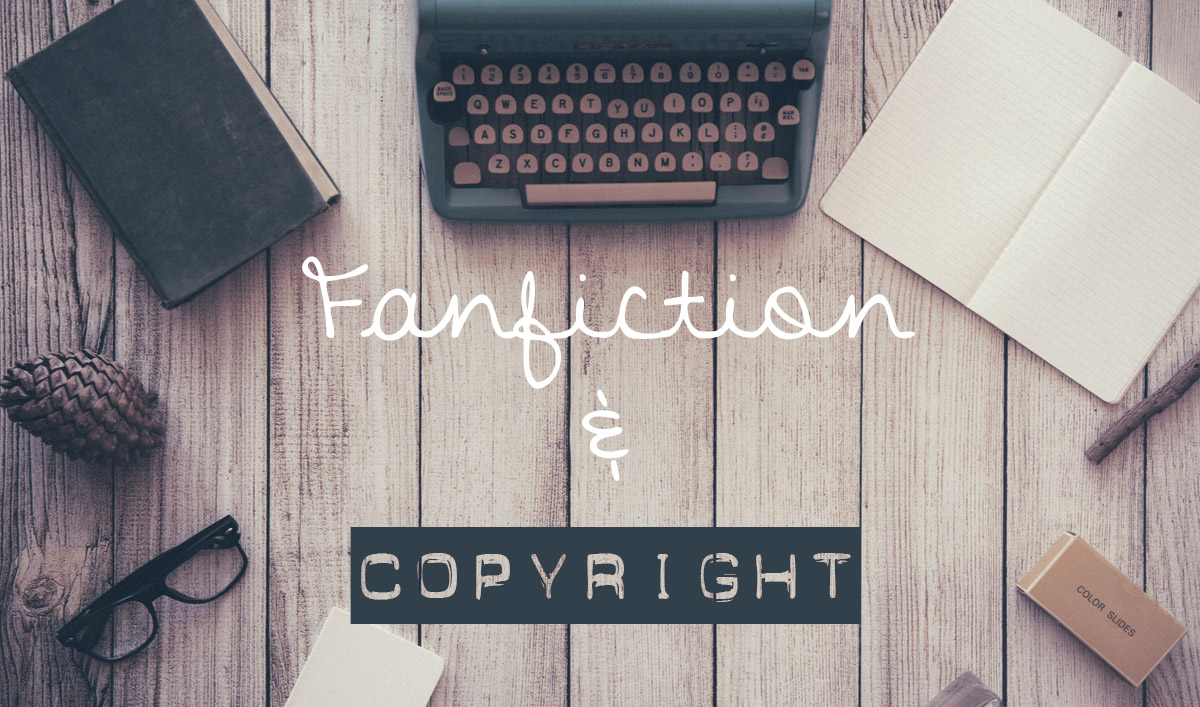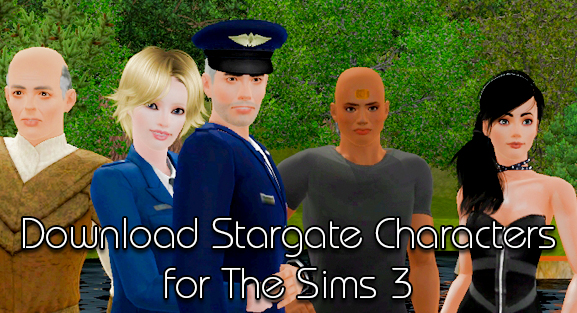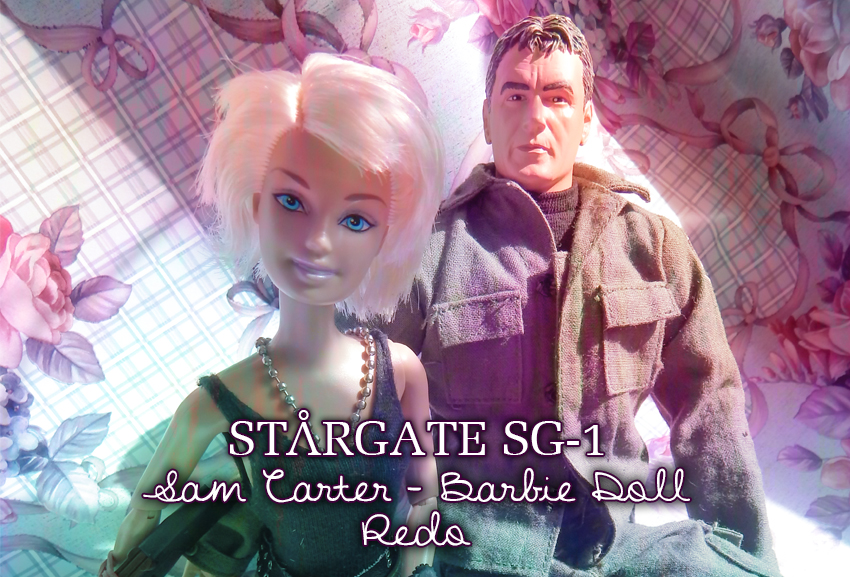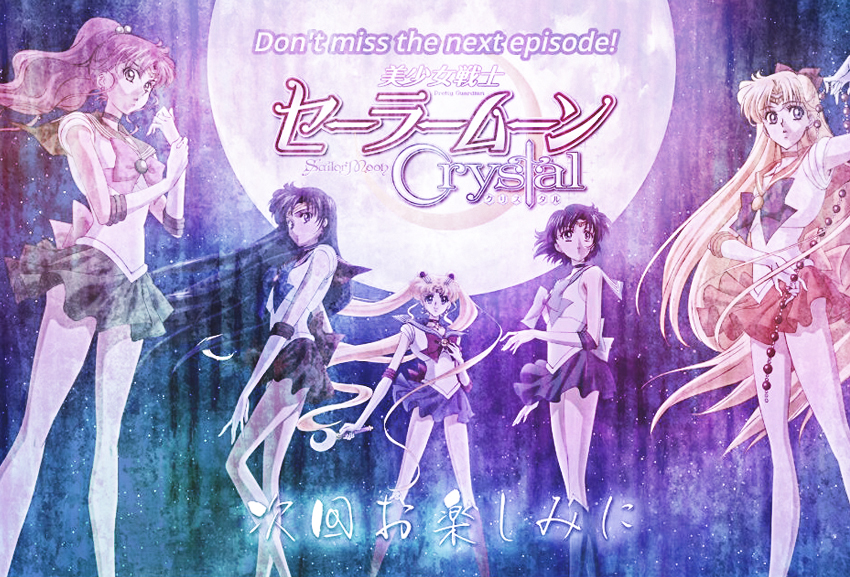
It has been 20 years since Naoko Takeuchi published the first chapter of “Pretty Guardian Sailor Moon” (Japanese Original Title: 美少女戦士セーラームーン) in the Nakayoshi magazine by the Japanese publishing house Kodansha. And even 20 years later, Sailor Moon and her friends are well known and loved.
Now, in order to celebrate the 20th anniversary, Toei Animation has released a re-make of the original Anime series. This is not the first makeover that Sailor Moon has received during the course of the past decades. In 2003, all 18 Sailor Moon mangas were re-released in a digitally enhanced version in 12 new volumes which feature new artwort by the mangaka. Naoko Takeuchi also re-drew countless scenes for the release.
In 2013, Sailor Moon was again re-released. The 2013 release has not been translated internationally yet and is only available in Japan. But why are so many people fascinated with a supposed children’s television show? Where does the fascination come from?
The answer to this question is more complex than one might think. The original story in manga form features many aspects which are directed towards a more adult audience. If Sailor Moon had been a novel (or trilogy) instead of a manga series, there are good chances that it would have become an international bestseller much like Harry Potter or Twilight, which were also written for teens, but are now being read by fans of all ages.
Sailor Moon, however, was an anime – and got stamped to be a simple ‘cartoon’ by our prejudiced Western societies. In Japan, manga and anime have long been part of the culture for all ages. It is not at all rare or uncommon in Japan to find adult or even elderly people who passionately read manga – because in Japan the comic book does not have the cultural stigma ‘for children only’ attributed to it. In Western societies, people who read manga or comic books are often considered immature. (Believe me, I know – and let me tell you, it’s worse if you draw that stuff… ;) )
So what happens if a show which is, in its original form directed towards a teen and adult audience, becomes stamped as a children’s show in other countries? Censorship, because of course the cartoon featured a lot of characteristics which many countries and production studios found unsuitable for a young audience. (Even though many of those are debatable. To me it is still a despicable act of homphobia to turn a lesbian couple into cousins to explain their subtle intimacy! Or turn one of the partners in a gay relationship into a female by giving him a female voice, thereby turning them into a heterosexual couple.)
Those censorships happened most drastically in the US, where even a lot of the more severe scenes were cut or even altered. The original Japanese season 1 of the anime ends with Sailor Moon and all her friends sacrificing themselves in their battle to protect Earth. Sailor Moon’s dying wish is to be reborn as a normal girl to live that normal life doing ordinary things again, and the legendary silver crystal grants them her last wish.
It is a beautiful, almost philosophical ending with a heartbreaking monologue of the main character Usagi Tsukino – which was entirely edited out in the United States. Why? Well, that remains a mystery until today, because the show had to be edited around that, and in the end the US version confused many fans because it didn’t make sense anymore. Apparently the American production company thought that heroines dying and showing homosexual love weren’t suitable entertainment for children in a culture in which male superheroes stood above everything else.
The censorship debate is also why Sailor Moon is rarely being re-released in other countries. There have been numerous requests, especially in the past decade, by German as well as US production companies to re-release Sailor Moon, or even re-dub it. However, the author, Naoko Takeuchi, is putting strict limitations on the new licenses and one of the first and foremost conditions of a re-release would be that it is correctly tanslated and not censored. Many fans are angry because of that, but I can only say: Bravo for taking such a stand! It is not an unreasonable demand. I think an artist has the right to demand that, if other countries purchase the rights to show their art, they do not mutilate the original story to meet some imagined requirements that they put onto themselves by stigmatising and marketing the show as kids show in the first place.
The Story
Sailor Moon is the story of 14-year-old Tsukino Usagi (Translation: Moon Rabbit) who is the reincarnation of the daughter of the moon goddess. She, her mother and their entire court inhabited the moon thousands of years ago during the time of the ‘Silver Millenium’. Usagi (or Princess Serenity as she was called then) fell in love with the King of Earth, Endymion, and they became lovers. However, Beryl, who was also in love with Endymion became jealous, and her jealousy opened the door for chaos to enter her heart, which turned her into the evil Queen Beryl who began to wage war against the moon kingdom. The war ended when Queen Serenity (Usagi’s mother) sacrificed herself by making use of the Legendary Silver Crystal, a mystical stone with unthinkable powers. It was too late. Everybody had died: Princess Serenity and Endymion, the Sailor Warriors Mercury, Marc, Venus and Jupiter who made up the protection guardians of the princess, and all others.
In present day Tokio, Serenity and the Sailor guardians are reborn and have to reawaken because chaos (in the form of Queen Beryl) from a time long past is returning. So they start fighting anew, each one of them born from the energy of one of the planets.As the story progresses, later on Sailor Guardians from the outer solar system join them: Uranus and Neptune, Pluto (yes, Pluto was still considered a planet back then ;) ) and Sailor Saturn, who is so powerful that using her power means she destroys evil as well as good.
Sailor Moon is the story of female emancipation, of growing up as well as liberating oneself from the stereotypes society puts on women. Sailor Moon was revolutionary, because it is counted to be the first one in the ‘Magical Girls’ manga category. ‘Magical girls’ was a whole new category in which women and girls were the heroines; strong soldiers who didn’t need men to protect them, but were strong enough to stand on their own. From a gender studies perspective, in many ways the Sailor Senshi represent the Japanese version of the liberated woman pioneers. Fitting counterparts in Western cultures would be Dana Scully (The X-Files), Samantha Carter (Stargate SG-1) or Kathryn Janeway (Star Trek Voyager).
Sailor Moon is more than a feminist statement though: it is a beautiful fairytale. The tragic romance of the princess of the Moon, who, long ago, fell in love with a the king of the Earth – and even though their feelings were mutual, evil forces prevented them from being together until, in present day, they are given a second chance. Will they manage to win against chaos this time?
I wonder how many people passed up on this beautiful story simply because it was in the format of manga, and they attributed ‘childishness’ to it just by the fact that it was by Western standards nothing but ‘a comic book’.
Sailor Moon – The 1993 Anime vs. Pretty Guardian Sailor Moon – The Manga
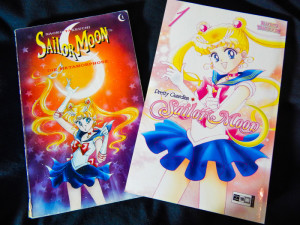
Sailor Moon – Original Manga vs. Remake (German Versions)
The original manga and the anime television show that was released in 1993 don’t have a lot in common. The television show is very drawn out and, in comparison to the story in the manga, it is very superficial and almost, to a point, childish. At least that is how Westeners would perceive it. Those who watch Japanese Dramas (J-Dramas) will realize that this perceived ‘childishness’ is part of Japanese adult culture.
Unlike in the manga, in the 1993 anime Sailor Moon and her female warrior friends always seem to need the protection of Tuxedo Kamen (the handsome reincarnation of King Endymion who later on becomes Usagi’s lover). The role of Tuxedo Kamen in the 1993 anime is so overplayed that often one has to wonder why on Earth Sailor Moon is considered to be a heroine anyway.
Naoko Takeuchi herself had a much more feminist idea in mind, and that idea is reflected in the manga. She wanted to create heroines who didn’t need a man to protect them, but who were strong enough to stand and fight by themselves. And so the Sailor Moon manga (unlike the 1993 anime) reversed a lot of the traditional gender roles – a revolutionary accomplishment for Japan (or anywhere!) in the early 1990s. The most prominent example of Western television is The X-Files Dana Scully, in which traditionally attributed values got reversed. Traditional: female – emotional, illogical, intuitive; male – rational, logical, scientific. The X-Files plays around with that by making Scully (the female) the rational, logical and scientific one, whereas Mulder (the male) is the emotional and intuitive believer.
Sailor Moon does the same by butting women in the position of the active ones, whereas the males become passive – a complete reversal of Japanese gender ideals and cultural ideas.
Many stories were altered for the anime version of Sailor Moon. The reason for that was a practical more than an artistic one: Naoko Takeuchi only published one chapter a week in the Nakayoshi magazine, and so the anime had to progress a lot faster than the manga – which lead to the anime production team taking a lot of creative liberties.
The end result is that manga and anime are so different that one almost perceives them as two different stories.
Sailor Moon Crystal – The 20th Anniversary Sailor Moon Re-Make
Sailor Moon Crystal is an attempt at closing the gap between the manga and the anime of Sailor Moon. And entirely new cartoon series which retells the story of the manga, while staying as close to the material as possible. Consequently, even the character designs are a lot closer to the ones that were originally created by Naoko Takeuchi.
Here you can see one of the 1993 anime character designs. Sailor Moon looks well rounded and very childish, and in comparison to the manga, her Sailor Senshi costume lacks a lot of the original details.
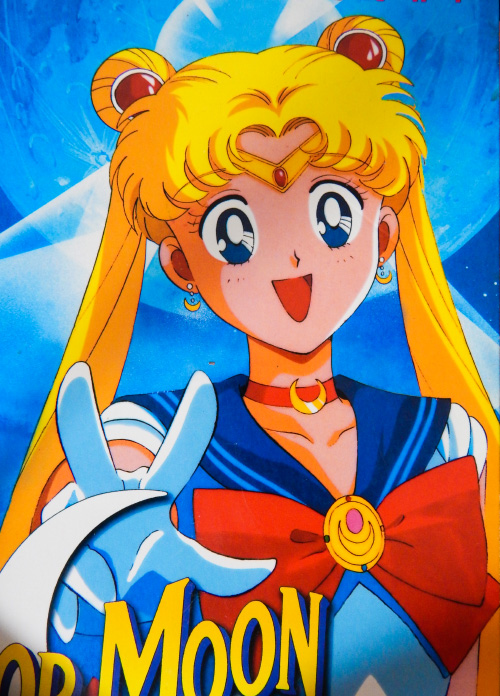
Sailor Moon Anime Design 1993
Whereas in the 2014 version, she looks a lot closer to the designs that Naoko created for the mangas. The white feather hair clips and other details on her uniform are exact copies of Takeuchi’s original designs.
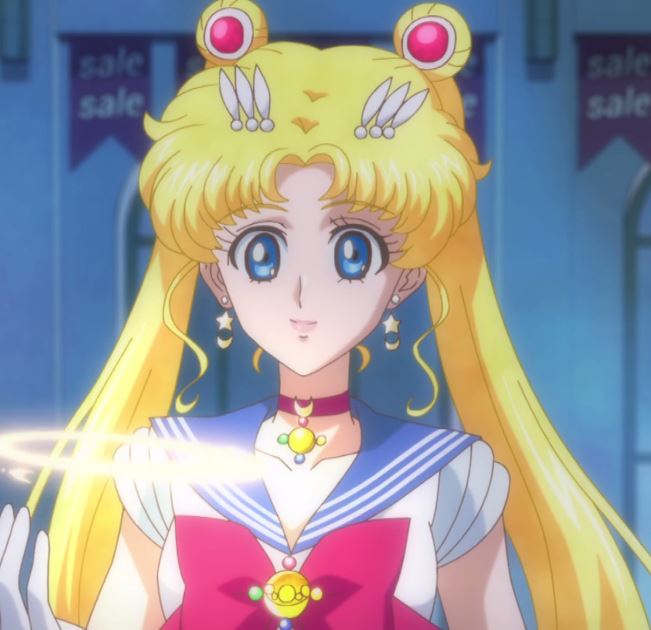
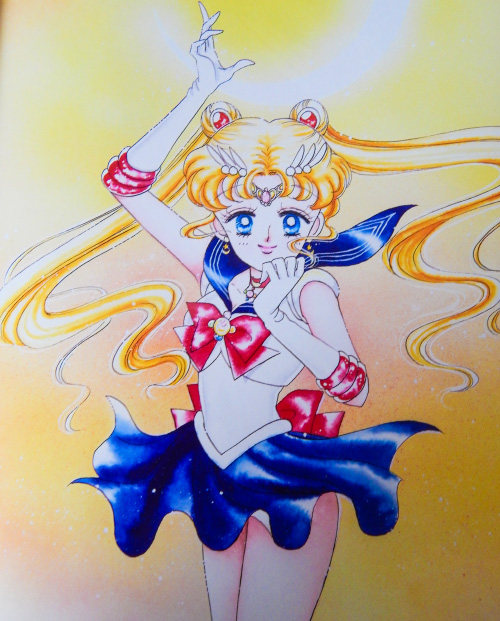
Sailor Moon Crystal – Review
The first five episodes of Sailor Moon Crystal have aired already in Japan, and thanks to modern technology, international folks like me have the chance to watch the show online. (I put a link to where you can watch it legally at the end of this article.)
My first impression is somewhat balanced. I was a huge fan of the Sailor Moon franchise back in the 1990s, and collected all kinds of Japanese materials. I even went so far as to translate the Sailor Moon mangas from Japanese as a way to circumvent the censorship imposed on me in my own country – which is, btw, where my Japanese language skills originate from. ;) Therefore I was understandably excited when I heard that there was going to be a remake of Sailor Moon which was supposed to deal with the story told in the manga.
The first two episodes left me a little bit disappointed. The 1993 anime of Sailor Moon was vivid in humor, had a world class soundtrack (composer was Takanori Arisawa) and just swept the viewer away. Sailor Moon Crystal is a lot more fast-paced – which, if I am honest with myself, I should have expected seeing that the manga itself was very fast paced. However, what bugged me was the use of cheap CGI effects in the transformation of Sailor Moon, whereas the rest of the anime remains largely hand-drawn. Therefore the difference is visible and the effects destroy the ambient a little. I would have preferred had the animators used their talent to animate the transformation and attack patterns by hand as they did with the rest of the show.
The soundtrack is also nothing that sweeps me off my feet. There are no catching tunes (except for maybe the main title) that stay in one’s head.
Here are comparisons of the Sailor Moon theme song of 1993 “Moonlight Densetsu” (Legend of the Moonlight) vs the 2014 song “Moon Pride”.
There is also a new version of “Moonlight Densetsu” which was apparently either produced as a special or fan-created for Sailor Moon Crystal.
Even the new version of “Moonlight Densetsu” sounds a lot more modern – which is understandable since it is 2014 and not 1994 anymore. What I personally miss though, and what drew me into the original Sailor Moon show, are the wonderful instrumentals that transfer the emotions of the characters.Example: Moonlight Densetsu was actually the melody from an old music box that, at the time of the “Silver Millenium”, King Endymion gave Princess Serenity as a gift. Modern day Usagi has intuitive memories of her past when she heards the melody. And that particular melody returned in the form of numerous beautiful instrumentals throughout the entire show.
Moonlight Densetsu in its original music box and enhanced background instrumental form
Moonlight Densetsu Instrumental Compilation
http://youtu.be/PsBqcKvCq1Q?t=30s
What I miss about “Sailor Moon Crystal” are exactly those tunes that you recognize, those that you remember and attribute emotions to.
We are only five episodes into the show, and to me the show really took off with Episode 4. Episode 1 left me somewhat disappointed, and even episode 2 didn’t really make up for that yet. However, when they started changing things here and there and I began to recognize the actual story of the manga, I was drawn into it. Now I am waiting to see where they will take the show. So far four of the Sailor Guardians have made an appearance.
Character Design of Sailor Moon Crystal
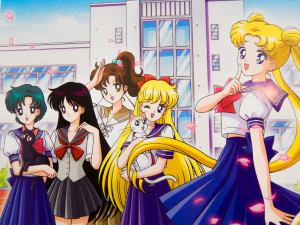
Sailor Moon Team Character Design 1993 Anime
Do I like the character design of Sailor Moon Crystal? Yeah, there’s a simple answer. It’s not for me, at least not the way they did it. I wasn’t very fond of Naoko Takeuchi’s style either, because she has a lot of problems drawing proportions right, drawing hands and limbs in the right dimensions, etc – and it seems the Sailor Moon Crystal team has deliberately taken those flaws into their character design.
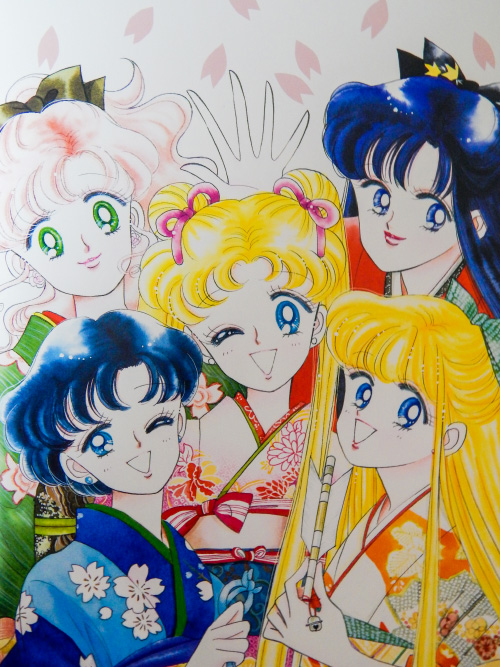
Sailor Moon Manga Team Character Design
Also, and that might be the main point of criticism for me, the Sailor Moon crystal characters don’t look like 14-year old girls. Usagi Tsukino and her friends are 14 or 15 years old. In the new anime version they look like fully grown adults though, and I find that a bit confusing.
I think the original anime team accomplished that aim better than Takeuchi did. Look at these two pictures which compares the 1993 anime character designs of the Sailor Senshi with one of the illustrations in her first artbook.
At the end of the Sailor Moon series, all girls were supposed to be 18 years old – in the manga they were supposed to be even older since it ends with Usagi and Endymion being married and having their first child, but the manga covered a larger timespan overall. Therefore it would make sense if one saw the Senshis gradually age as the series progressed. I can’t see 14-year-old girls looking that mature though, so that is a major design flaw for me.
That I like is that the characters look overall softer, and the lines don’t stand out that harsh. That however I can’t really hold against the old anime since technology and even trends were a lot different then.
Sailor Moon Crystal – Naoko’s Feminist Heritage
The one thing I really love about Sailor Moon Crystal so far is its strong undercurrent of female self-reliance – which already shines through in the intro lyrics. There is none of that 1993 anime ‘weak-girl’ ambient. Sailor Moon doesn’t need Tuxedo Kamen to protect her anymore – rather, so far, he seems to be nothing but a pale bystander who doesn’t get to do anything. And that comes fairly close to how the manga story was. In the manga it was Usagi rescuing Tuxedo Kamen countless times. She was the strong one. So I am intrigued to see where the show will take this aspect. If the lyrics in the “Moon Pride” intro are any indication, the show is going to follow that line strictly.
I will definitely keep watching that show. The new “Moon Pride” promotional trailer was released a few weeks ago, and it features a number of clips from later on in Crystal, and the effects look truly stunning. So I am intrigued to see where the makers will take that beautiful legend of the moon princess who fell in love with the king of Earth.
For all of you who got interested in watching the show, the Japanese online streaming channel NICOVIDEO is broadcasting the show for free at the moment. International folks can watch the current episodes online. If I remember correctly, all you need is a free niconico account – at least I had to make one. It might be you can watch it without an account as well. The show will be in Japanese with English subtitles. French and other languages should also be available.
And the long-term fans of the show should wait until October, when Toei Animation will release the official Blu-Ray Set of Sailor Moon Crystal, which will contain digitally enhanced scenes. The production company announced last week that for internet streaming, they were using a low budget version of the show, whereas on Blu-Ray there will be a high quality rendering of certain scenes.


